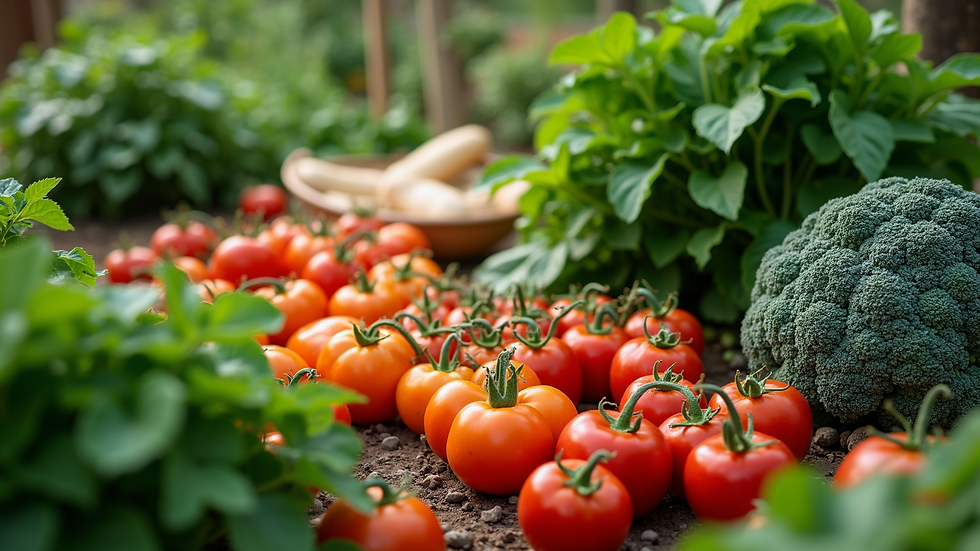Exploring the Journey of Growing Your Own Healthy Vegetables at Home
- Susan L. Hendrix

- Jul 29
- 4 min read
Growing your own healthy vegetables can be an incredibly rewarding experience. The process, from planting seeds to harvesting your fresh produce, is filled with moments that deepen your connection to both food and nature. Besides enjoying fresh vegetables, you’ll gain insight into where your food comes from and how it grows. Plus, studies show that home gardening can improve your mental well-being by reducing stress levels.
Why Grow Your Own Vegetables?
There are many compelling reasons to start a vegetable garden. First, homegrown vegetables are often free from harmful pesticides and chemicals that are commonly found in mass-produced options. Research suggests that homegrown produce can have up to 50% more nutrients compared to store-bought vegetables. This direct control allows for healthier eating habits.
Moreover, growing your own food can provide significant savings. For example, a small garden can yield around 200 pounds of vegetables annually, which could save you $600 or more in grocery bills. Then, there’s the unbeatable taste of fresh vegetables picked at their peak ripeness.
Getting Started: Planning Your Garden
Before you dive into planting, thoughtful planning can make a considerable difference. Assess the space you have, whether it's a backyard, balcony, or windowsill. Make sure to check how much sunlight your chosen area gets, as most vegetables require 6-8 hours of sunlight daily. Also, evaluate your soil type, as it can greatly affect plant growth.
Consider starting with easy-to-grow vegetables like lettuce or radishes, which can be harvested within weeks, or tomatoes, which typically take 60-90 days to mature. These choices are less demanding and can build your confidence as a gardener.
Choosing the Right Vegetables
When selecting vegetables, think about your family's preferences and available space. Here are a few excellent suggestions to consider:
Leafy Greens: Varieties like spinach, kale, and Swiss chard thrive in cooler temperatures. They can be harvested multiple times throughout the growing season.
Root Vegetables: Carrots and radishes grow rapidly. Radishes can be ready for harvest in just three weeks, while carrots may take around 70 days but are well worth the wait.
Fruiting Vegetables: Tomatoes and peppers require more care but often yield a bountiful harvest if nurtured properly. A single tomato plant can produce over 20 pounds of fruit in a season!
Taking the time to explore different varieties enhances your gardening experience and allows you to discover which types you truly enjoy.

Preparing Your Soil
Healthy soil is vital for growing flourishing vegetables. Start by testing your soil to determine its pH level and nutrient content. You can find inexpensive soil testing kits at gardening stores. Based on the results, consider incorporating compost or organic fertilizers.
Take the time to till your soil, which improves aeration and drainage, crucial factors for root development. If using containers, opt for high-quality potting soil to create a robust environment for your plants.
Planting Your Seeds or Seedlings
Once your soil is ready, it's time to plant. If using seeds, be mindful of the appropriate planting depth; it varies by species. For seedlings, dig holes slightly larger than the root ball and position them at the same depth as they were in their pots.
After planting, water your garden generously to help settle the soil around the roots. However, avoid overwatering, as this can lead to root rot, a common gardening challenge.
Caring for Your Garden
Caring for your garden requires ongoing attention. Here are some essential maintenance practices:
Watering: Vegetables typically need about one inch of water weekly. Early morning watering is effective as it reduces evaporation and helps prevent fungal diseases.
Weeding: Regularly inspect for weeds that compete for nutrients and water. Pull them out gently to minimize disruption to your vegetable plants.
Fertilizing: Depending on your soil quality, fertilizing every four to six weeks during the growing season can help enhance growth.
Pest Management: Keep an eye out for pests. Implement organic methods, such as using neem oil or promoting beneficial insects like ladybugs, to help manage unwanted visitors.
Creating a weekly garden routine can simplify these tasks, helping you maintain a thriving vegetable patch.

Harvesting Your Vegetables
The most satisfying part of gardening is harvesting your vegetables! Different vegetables have unique indicators when ready to pick. For leafy greens, you can generally harvest once they reach a size that fits your needs. Root vegetables like carrots should remain in the soil until they reach a desirable size, usually around 1 inch in diameter.
Remember, the more often you harvest, the more your plants will produce. Regular picking encourages continuous growth, ensuring you enjoy fresh vegetables throughout the growing season.
Preserving the Harvest
After your successful harvest, consider methods for preserving your vegetables to enjoy later. Here are a few effective options:
Canning: Ideal for tomatoes and pickles. Follow safe canning guidelines to ensure quality and safety.
Freezing: Many vegetables freeze well. Blanch them briefly before placing them in freezer bags for best results.
Drying: Herbs and some vegetables can be dried, adding unique flavors to your meals.
Using these preservation methods not only allows you to manage surplus produce but also lets you savor your homegrown vegetables throughout the year.
Embracing the Gardening Experience
Growing your own healthy vegetables at home is more than just a hobby; it’s a rewarding journey filled with opportunities for learning and enjoyment. Whether starting with a few pots on your balcony or transforming your yard into a flourishing garden, each step leads to personal satisfaction and growth.
So why wait? Embark on your gardening adventure today! Experience the joy of nurturing your own vegetables. It’s a fulfilling endeavor that reconnects you with nature while promoting a healthier lifestyle.



Comments